
Pentax Corporation was a Japanese camera and optical equipment manufacturer, and currently, it exists as the Pentax Life Care Business Division of Hoya's medical endoscope business, as well as the digital camera brand of Ricoh Imaging, a subsidiary of Ricoh.

A digital single-lens reflex camera is a digital camera that combines the optics and mechanisms of a single-lens reflex camera with a solid-state image sensor and digitally records the images from the sensor.

Sigma Corporation is a Japanese company, manufacturing cameras, lenses, flashes and other photographic accessories. All Sigma products are produced in the company's own Aizu factory in Bandai, Fukushima, Japan. Although Sigma produces several camera models, the company is best known for producing high-quality lenses and other accessories that are compatible with the cameras produced by other companies.

Advanced Photo System type-C (APS-C) is an image sensor format approximately equivalent in size to the Advanced Photo System film negative in its C ("Classic") format, of 25.1×16.7 mm, an aspect ratio of 3:2 and Ø 30.15 mm field diameter. It is therefore also equivalent in size to the Super 35 motion picture film format, which has the dimensions of 24.89 mm × 18.66 mm and Ø 31.11 mm field diameter.
The Contax N Digital was a six-megapixel digital SLR camera produced by Contax in Japan. The camera was announced in late 2000, and began to be sold in spring 2002, after several delays. The camera received mixed reviews from the press, and was withdrawn from the market within a year of its introduction.
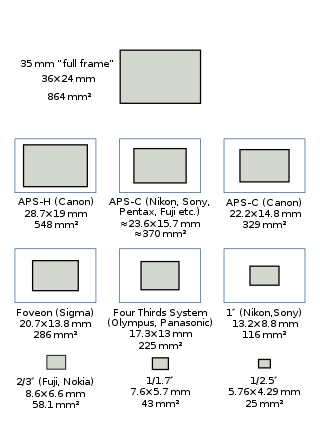
A full-frame DSLR is a digital single-lens reflex camera (DSLR) with a 35 mm image sensor format. Historically, 35 mm was one of the standard film formats, alongside larger ones, such as medium format and large format. The full-frame DSLR is in contrast to full-frame mirrorless interchangeable-lens cameras, and DSLR and mirrorless cameras with smaller sensors, much smaller than a full 35 mm frame. Many digital cameras, both compact and SLR models, use a smaller-than-35 mm frame as it is easier and cheaper to manufacture imaging sensors at a smaller size. Historically, the earliest digital SLR models, such as the Nikon NASA F4 or Kodak DCS 100, also used a smaller sensor.
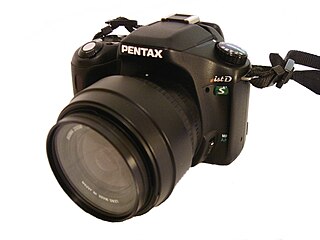
PENTAX *ist DS is a digital SLR camera produced by Pentax. The *ist DS produces a 6.1 megapixel resolution image. The *ist DS was a lower-prices follow-on to the Pentax *ist D. In September 2005 the Digital Imaging Websites Association (DIWA), a worldwide organization of collaborating websites, announced that Pentax had received their first DIWA Award for a DSLR camera. The *ist DS model was awarded with a Silver medal for outstanding test results.

The Olympus E-400 is a digital single-lens reflex camera launched by Olympus on 14 September 2006, using the Four Thirds System lens mount standard. This 10 megapixel camera could be compared to other DSLRs unveiled during the summer of 2006 with comparable pixel count and price range: the Sony α 100, the Nikon D80, the Canon EOS 400D and the Pentax K10D.
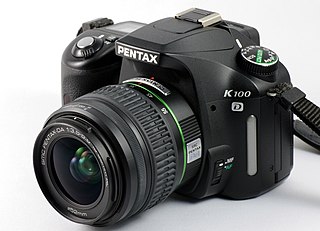
The Pentax K100D and similar Pentax K110D are 6-megapixel digital single-lens reflex cameras, launched in the U.S. on May 22, 2006. The K100D has a maximum resolution of 3008 x 2008, and can also down-sample to 2400 x 1600 and 1536 x 1024. The slowest metered shutter speed is 30 seconds and the fastest shutter is 1/4000 seconds.

This article details lensesfor single-lens reflex and digital single-lens reflex cameras. The emphasis is on modern lenses for 35 mm film SLRs and for "full-frame" DSLRs with sensor sizes less than or equal to 35 mm.

The Pentax K20D and its clone, the Samsung GX-20, are 14.6 megapixel digital single-lens reflex cameras manufactured by Pentax that were announced on January 23, 2008. The K20D was available in the U.S. market from February 2008 through autumn 2009.

The Kodak Digital Camera System is a series of digital single-lens reflex cameras and digital camera backs that were released by Kodak in the 1990s and 2000s, and discontinued in 2005. They are all based on existing 35mm film SLRs from Nikon, Canon and Sigma. The range includes the original Kodak DCS, the first commercially available digital SLR.
This article discusses the cameras – mainly 35 mm SLRs – manufactured by Pentax Ricoh Imaging Corp. and its predecessors, Pentax Corporation and Asahi Optical Co., Ltd.. Pentax must not be confused with Pentax 6x7 or Pentax 67 which are 120 medium format 6x7cm film cameras.

Pentax lenses were first badged as Takumar. The Takumar branded lenses were well respected for their line of Super Takumar, which designated the high performance coating applied to the lens as well as the optical formulas used to make them. The majority of the industry at the time was still satisfied with the variations of the "plumb" coating process and later some of the two and three layer processes as well. Asahi Pentax soon introduced the Takumar Super-Multi-Coated line of lenses which was a 7 layer process as the industry had just caught up with similar forms of 5 layer multi-coated optics. Eventually Asahi Optical and Pentax slowly shifted much of their lens production under the Pentax name and transitioned some of the successful designs that were first introduced under the Takumar name to use Asahi/Pentax badging as well as beginning to use the "smc" abbreviation. Eventually the Asahi partnership disappeared and the Pentax name became solely used. Pentax lenses saw many feature changes to answer the market, such as: incorporating "Auto-Aperture" with the M42, the light weight and compactness with the 'M' series, Aperture Priority overrides with the 'A' series, and Auto-Focus with the 'F' series. Modern Pentax lenses for digital SLR cameras have seen the elimination of the aperture ring completely as found on Pentax DA and D-FA series lenses. They use the Pentax KAF mount. All of these lenses have an autofocus feature, either operated from the camera body or from an internal SDM motor. Pentax compatible lenses are also made by third-party companies.

The Canon EOS 500D is a 15-megapixel entry-level digital single-lens reflex camera, announced by Canon on 25 March 2009. It was released in May 2009. It is known as the EOS Kiss X3 in Japan, and as the EOS Rebel T1i in North America. It continues the Rebel line of mid-range DSLR cameras, is placed by Canon as the next model up from the EOS 450D, and has been superseded by the EOS 550D (T2i).

The Pentax K-x is a 12.4 megapixel digital single-lens reflex camera, which was announced on September 16, 2009. The Pentax K-x uses a Sony Exmor sensor. In some cases it even approaches the quality produced by full-frame DSLRs like the Nikon D700 and the Canon 5DMkII, both with larger sensors. The Pentax K-x is suitable for low light conditions for both still and video photography.
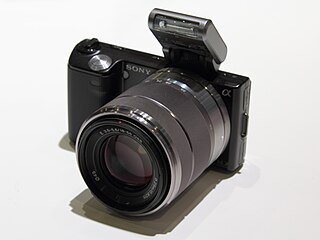
The Sony α NEX-5 is a digital camera launched on 11 May 2010. It is a mirrorless interchangeable lens camera with the body size of a larger model fairly compact point-and-shoot camera with a larger sensor size (APS-C) comparable to that of some digital single-lens reflex cameras. Its major competitors in the market are the cameras based on the micro 4/3 standard created by Panasonic and Olympus, and a few low end Canon, Nikon, and even Sony α DSLRs. The NEX-5 shoots 14.2 megapixel stills and has a 7 frame/s continuous shotmode. It has the capability to shoot 1920×1080i at 60 frame/s in AVCHD or 1440×1080p at 30 frame/s in MPEG4. The NEX-5 was replaced by the 16 megapixel NEX-5N in August 2011.
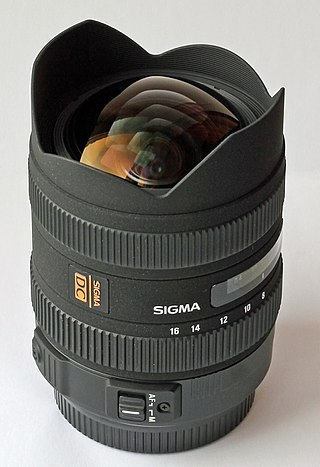
The Sigma 8–16mm lens is an enthusiast-level, ultra wide-angle rectilinear zoom lens made by Sigma Corporation specifically for use with APS-C small format digital SLRs. It is the first ultrawide rectilinear zoom lens with a minimum focal length of 8 mm, designed specifically for APS-C size image sensors. The lens was introduced at the February 2010 Photo Marketing Association International Convention and Trade Show. At its release it was the widest viewing angle focal length available commercially for APS-C cameras. It is part of Sigma's DC line of lenses, meaning it was designed to have an image circle tailored to work with APS-C format cameras. The lens has a constant length regardless of optical zoom and focus with inner lens tube elements responding to these parameters. The lens has hypersonic zoom autofocus.

The Pentax K-3 is a 24-megapixel Pentax high-end digital single-lens reflex camera with an APS-C sensor, announced on 7 October 2013. The Pentax K-3 is the successor to both the K-5 II and K-5 IIs models, which have a 16-megapixel sensor. The K-5 II had an optical low pass filter or anti-aliasing (AA) filter that can prevent the appearance of moire patterning on the captured image. This filter reduces the sharpness of the image, so Pentax also produced the K-5 IIs which omitted this filter. In the K-3, Pentax obviated the need for providing two separate models by including a selectable AA filter "simulator". This mechanism vibrates the sensor when switched on, slightly blurring the image in a way that replaces the function of the optical AA filter, providing the same benefit as the filter in the K-5 II and other cameras with an optical AA filter. When the AA simulator is disabled, the sensor records a sharper image, as in the K-5 IIs.
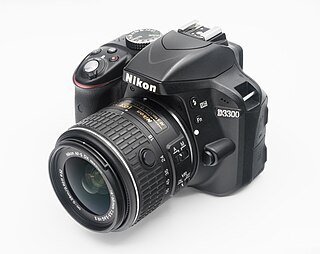
Nikon D3300 is a 24.2-megapixel DX format DSLR Nikon F-mount camera officially launched by Nikon on 7 January 2014. It was marketed as an entry-level DSLR camera for beginners and experienced DSLR hobbyist who were ready for more advanced specs and performance. It replaced the D3200 as Nikon's entry level DSLR. The D3300 usually came with an 18-55mm VR II kit lens, which is the upgraded model of older VR lens. The new kit lens has the ability to retract its barrel, shortening it for easy storage.























